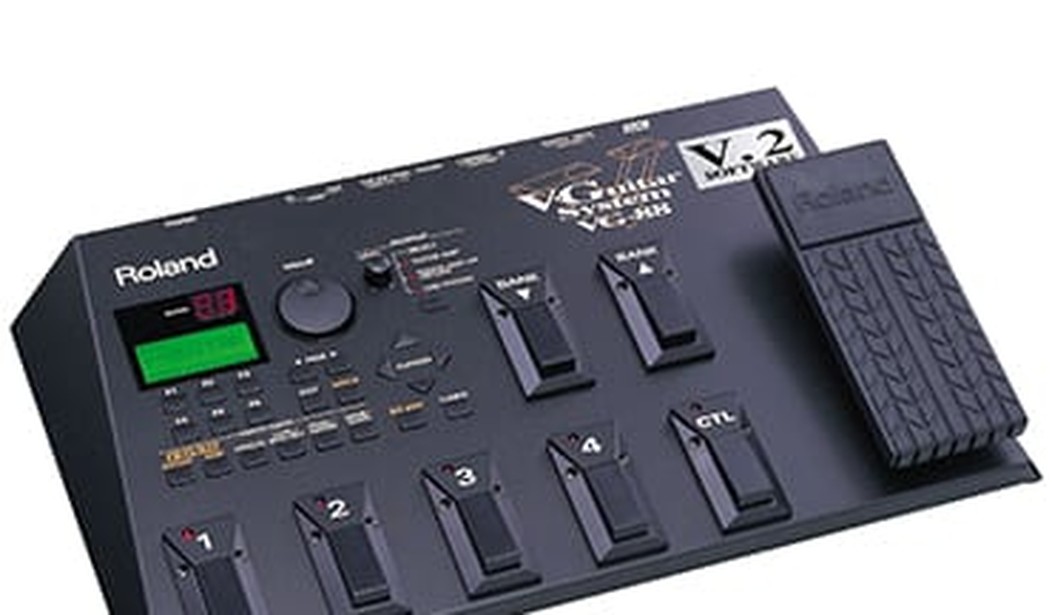Note: This article originally ran on January 10, 2007 at Blogcritics.org, where I was among its earliest and most prolific contributors. I wrote numerous essays, interviews and product reviews there until about 2009 or so. At some point in late 2017, the current management at Blogcritics chose to remove all of my articles without notifying me, and have yet to respond to my email requests for an explanation, or to let me know how to restore them there. (Accidents happen on the Internet; perhaps it was just a glitch?) In the interim, I will slowly be reposting my more interesting pieces here.
It’s no secret that most electric guitar players are reluctant to move beyond vintage, or even vintage-looking gear. For many guitar players, anything newer than a 1959 Les Paul or ’57 Stratocaster, and a mid-1960s Marshall amplifier is suspect.
However, for those who are a bit more adventurous, the Roland VG-88 Guitar Modeling System is both a great tool for the working guitarist, and a glimpse into the future of the electric guitar itself.
The unit comes with 160 presets, and more are available to download into the unit from various Websites, including the VG-88’s wiki. Flipping through the unit’s presets is much like dialing up various patches on a keyboard synthesizer, except the emphasis of course is on various guitar sounds. But like most keyboard synths, there are some truly exceptional presets, some extremely good ones, some offbeat sounds, and a few “what were they thinking?” clinkers.
For the full impact of the VG-88, a guitar equipped with a Roland GK-2A MIDI pickup is required, available as an aftermarket bolt-on device, or built into guitars such as Fender’s Roland-ready Stratocaster. A nice touch on the VG-88, however, is the presence of a conventional quarter-inch input jack, thus allowing electric guitarists who’ve built up a collection of instruments to at least use the VG-88’s electric amplifier modeling patches and effects. On say, the “Fat 1959” patch, plugging in a conventional electric guitar produces a nice roaring lead sound.
However, a conventional electric without a synth pickup won’t be able to play some of the more advanced patches in the VG-88, and here’s where the unit really shines.
Many Tonal Colors For Recording, Playing Live
Of the exceptional presets are the nylon string guitar, the 12-string acoustic guitar, electric sitar, and several bread and butter electric guitar tones. The 12-string acoustic has a really sweet timbre; think Melissa Etheridge, or The Sundays. Additionally, it also has a huge stereo spread, which is a marvelous touch — when recorded in stereo, arpeggiated pans move from across the stereo field for a beautiful, liquid sound, somewhat akin to the ping-pong stereo effects the Fender Rhodes electric pianos of the 1970s could generate.
The nylon string sound is certainly the equal of dedicated acoustic/electric nylon string guitars, such as the Gibson Chet Atkins model Classic Electric solid body nylon string guitar.
And the electric sitar patches are also rather nice. In fact, the VG-88 saved me the purchase of real 12-string and nylon string guitars, and an electric sitar. I like having examples of all of those available for their tonal colors when recording, yet none are instruments that I would normally play. But I actually wandered around the annual Dallas Guitar Show last April seriously looking for a good Classic Electric Chet Atkins model or affordable 12-string. And I’ve given serious thought to purchasing an electric sitar from time to time.
In other words, for the serious home recordist or working session guitarist, the VG-88 would be a great tool to have in the arsenal. As Kevin Shirley, who’s engineered albums for Led Zeppelin, Iron Maiden and Aerosmith once said of the unit’s immediate predecessor, the VG-8, “As far as newer equipment that’s come in, I love this Roland VG-8 guitar synthesizer. That’s fantastic. I’ve used that for a while, and I’ve always introduced it to guys in the other bands, and they always say, “You’ll never see us touch them.” When we did the Aerosmith album, I showed Joe Perry my VG-8, which I put a little pick-up on one of my Strats. He was like, “Nah, I’ll never use that. If I use a 12-string, I’ll use a 12-string.” But if you see him live now, he’s got a VG-8 hooked up. I love that. And Neal Schon uses it. And this new band with Jason Bonham, Healing Sixes, uses it.” (For our Blogcritics interview with Shirley, click here.)
Limited But Usable Guitar Synth Models
While the emphasis on the VG-88 is modeling traditional electric and acoustic guitars, the unit has several guitar synthesizer presets, which are strongly reminiscent of Roland’s original guitar synthesizers of the early 1980s. (Listen to Andy Summers and Robert Fripp’s I Advance Masked from 1982, it’s practically a demonstration disc for these early Roland guitar synths.) There are some great warm flute-like analog patches, and a patch somewhat reminiscent of the Polymoog synth that Gary Numan played on his classic hit “Cars”. There’s also a nifty, highly usable Hammond B3-style organ patch, and a terrific Pat Methaney-style patch called “12ST 5th”, (12 string with fifths instead of octaves) for wonderfully huge chordal sounds.
Unlike some previous guitar synths, the tracking of the VG-88 is flawless. It’s possible to rip up and down most of the synth patches with the same speed and accuracy as a regular electric plugged into an amp. Finger vibrato, bent notes, and whammy bar techniques also work just fine with the VG-88.
And that’s the trade-off for the VG-88 synth patches. While the sounds that today’s keyboard synthesizers are capable of have move far beyond these tones, these are all great, usable patches, perfect for the musician who’s more capable on guitar than he is on keyboard. (Err, like me!) For recording, one obvious possibility would be to use a modern keyboard synth interface (or Roland’s GI-20 MIDI guitar to USB interface) to play lush chords via the more harmonically complex software synths available today, and play the lead parts via one of the VG-88 patches.
While the VG-88’s built-in tuner is no replacement for the precision of a strobe-style tuner such as Peterson’s Virtual Strobe, it’s certainly a useful feature, particularly for live playing.
England’s Sound On Sound magazine once dubbed the aesthetics of the VG-88’s black metal case as a cross between a doorstop and the Stealth Bomber, which seems apt. Its patches are designed to be easily switched via foot pedals, thus making it easy for the gigging guitarist to change tones between songs, or if necessary, during a song. There’s a larger foot pedal on the right of the unit that depending upon the patch, will typically act as a volume pedal or wah-wah. On a few patches, it controls the speed of the Leslie or Tremolo effect, and on at least one patch, rocking it back and forth raises and lowers the guitar’s pitch over an octave. There’s loads of fun Van Halen-style dive-bomb tricks in this patch, and you don’t even need to route your guitar for a Floyd Rose!
Is It Perfect? Err, No
Are there downsides to the VG-88? As I said, a few of the presets sound awfully cheesy. And a number of them come from the factory smothered in reverb, perhaps to make beginning guitarists sound their best when they demo the unit in the music store, much like television sets usually have their brightness cranked waaaaay up to look good on the showroom floor. But that’s easy enough to dial back.
While the unit is capable of allowing a Roland-ready guitar in standard tuning to play in alternate tunings (such as Open-E or Keith Richards’ favorite tuning, Open-G), these VG-88 created tuning conversions sound far better playing chords than single notes and arpeggios. There’s a microscopic but still noticeable glitch or overtone when the VG-88 transposes a note into anything other than octave, for example, when the unit has adjusted the E string down to D, in Open-G tuning.
Still, if I was playing live, and my band had to do one song in open tuning (Say “Start Me Up” or “Brown Sugar”), this could be a viable alternative to carrying a second axe or retuning between numbers and slowing the pacing down. And speaking of which, there also some very usable bass patches, which would benefit the guitarist who needs to play bass from time to time live, but doesn’t want to schlep a Fender bass to the gig.
The VG-8/VG-88 wiki site has a wish list of features for Roland’s next generation guitar modeling product; I would like to see the ability to easily raise and lower the output an octave by pressing a foot pedal, particularly with the synth and keyboard patches. And an effects loop for additional, outside stomp-box effects would have been nice. Also, a pair of low impedance XLR outputs, and a digital and/or USB audio output would have been useful as well, though the combination of left and right quarter-inch outputs and a separate quarter-inch stereo out are certainly serviceable. Also the unit should come with USB-enabled patch editor software, and not rely on third party MIDI software to do the job.
But those are all relatively minor quibbles compared with what the VG-88 is capable of, and what it portends for the future of the electric guitar. That “Guitar Army” that Jimmy Page was always talking about in the 1970s? Its footlocker is here.










Join the conversation as a VIP Member